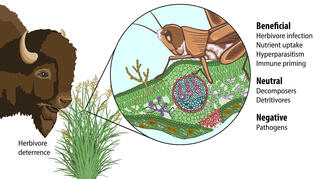Plant genetics impact above ground microbiome in bioenergy crops

Switchgrass may control the seasonal development of their leaf microbiome indirectly through a few immune-related genes.
The Science
An advanced bioenergy industry would use crops such as switchgrass to make fuel and chemicals traditionally produced by fossil fuels. Understanding the impacts of microbial communities on these bioenergy crops – and vice versa – could help maximize productivity, driving these crops toward being an attractive source of income for farmers. A recent publication from researchers in the Great Lakes Bioenergy Research Center (GLBRC) at Michigan State University examine ecological relationships between the advanced bioenergy crop switchgrass and its above-ground microbiome. They discovered specific switchgrass genetic patterns that control fungal growth on and in its leaves across geographic locations and growing seasons.
The Impact
Researchers found that there are ecological links between leaf pathogens and other types of leaf fungi, indicating that the focal immune genes may impact the whole microbiome by controlling just a few key pathogens. Identifying the genes that influence fungal communities can help breeders produce varieties that are better at recruiting beneficial microbes and fending off those that damage the plant, resulting in a higher yield. Knowing more about natural seasonal patterns in leaf microbes can help growers manage the timing of interventions such as application of fungicide.
Summary
The leaf microbiome is essential to plant growth and defense. A healthy leaf microbiome can increase nutrient uptake and defend from both herbivores and pathogens, whereas an unhealthy one severely impacts both biofuel yield and quality. To determine how both plant and non-plant factors influence the above-ground microbiome of the promising bioenergy crop, switchgrass, GLBRC researchers observed changes in the fungal microbiome in leaves of numerous switchgrass populations over the course of a season. Leaf fungal microbiomes are strikingly different between plants grown in northern locations (MI & MO) versus those grown in southern (TX). Researchers additionally matched up variation in the fungal community over time with similarities in switchgrass genetic patterns and identified links between gene expression in the plants and changes in the fungal community. Three specific gene locations in switchgrass demonstrate a role in controlling overall fungal community structure on the plants, though the mechanism for this role is not fully understood. The team observed how expression of these genes in switchgrass is more common in populations that are susceptible to fungal disease, showing where differences in plant DNA are most likely to influence plant growth and health.
Program Manager
Shing Kwok
Program Manager, Office of Biological and Environmental Research
shing.kwok@science.doe.gov, 301-903-2977
Corresponding Authors
Acer VanWallendael
Department of Plant Biology, Michigan State University
vanwall1@msu.edu, 517-432-4883
David B. Lowry
Department of Plant Biology, Michigan State University
dlowry@msu.edu, 517-432-4882
Funding
Support for this research was provided by the National Science Foundation Long-term Ecological Research Program (DEB 1832042) at the Kellogg Biological Station and by Michigan State University AgBioResearch. We received further funding from the U.S. Department of Energy through grants DE SC0014156 to TEJ and DE-SC0017883 to DBL and National Science PGRP Award IOS1402393 to J.T.L. The work conducted by the U.S. Department of Energy Joint Genome Institute is supported by the Office of Science of the U.S. Department of Energy under Contract No. DE-AC02-05CH11231.
Publication
VanWallendael, A., Benucci, G.M.N., da Costa, P.B., Fraser, L., Sreedasyam, A., Fritschi, F., Juenger, T. E., Lovell, J.T., Bonito, G. Lowry, D.B., “Host genotype controls ecological change in the leaf fungal microbiome.” PLOS Biology 20 (8): e3001681 (2022) [DOI: 10.1371/journal.pbio.3001681]
Related Links
https://journals.plos.org/plosbiology/article?id=10.1371/journal.pbio.3001681